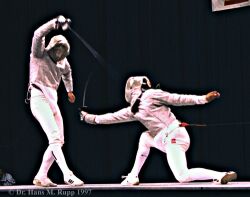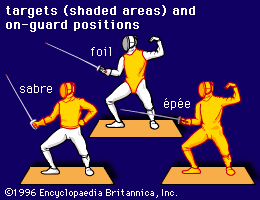Historically, Fencing is a European Martial Art. Many people have forgotten that we had our own martial arts in the West long before the rise in popularity of Eastern martial arts like Kendo, Karate and Tae Kwan Do.
Nowadays, Fencing is an exciting and dynamic sport, testing the athelete's brain as well as their physique.
Fencing Weapons and target areas:
|
Foil
|
Epee
|
Sabre
|
|
|
|
|
|
The foil is a light thrusting weapon with a flexible square-section blade. Modern foils have a safety button on the tip The epee is also a thrusting weapon, but has a heavier and less flexible triangular-section blade. The sabre is a cutting weapon, and has a flat-section blade. The sabre generally has a rounded tip to help it glance off jackets and masks easily. All sport fencing weapons are rebated (blunted) for safety. |
|
|
Two sabre fencers battle it out!
|
The different weapons have different target areas. In foil, the target area is the torso. The arms, legs and head do not count as legitimate targets. Foil is a thrusting weapon, so that legitimate hits can only be obtained by scoring a touch with the point of the weapon. Foil fencing is controlled by "right of way", where the fencer starting their attack gains a right-of-way, allowing their hit to gain priority over a last-minute counter-attack. Epee target area is the whole body, including feet, head and hands. Like foil, it is a thrusting weapon, but there is no "right of way" - whoever hits first usually scores. Sabre is a cutting weapon - hits are made with a cutting motion with the edge of the blade, rather than a thrust (although thrusts are permitted). The target area is everything above the waist, including head and hands. Some say this was a development from mounted cavalry training, to "kill the man, and spare the horse"! |
|
Historical Fencing
|
|
 |
Fencing
has been around since man first used swords... Egyptian frescoes from
1200BC show fencing as a sport with blunted weapons and specilaised
safety equipment. However, as a European martial art it has been documented
since pre-medieval times. Some of the best known early examples of documented
fencing manuals are:
The Tower Fechtbuch, known as Manuscript L33, written around 1280, describing sword-and-buckler combat in Latin with illustrations. 'Flos Duellatorum' (The Flower of Battle) written by Fiore dei Liberi in 1410 The 'Fechtbuch' by Hans Talhoffer, originally conceived in a number of verisons in the mid-15th century. Later, as the sword began to become more delicate (mainly thanks to the reduction in reliance on heavy armour as the primitive hand-cannon became more widespread), famous fencing masters like Achille Marozzo, George Silver, and later Angelo, emerged to turn fencing from a military discipline to a true martial art. |
|
The
Academy of European Medieval Martial Arts has a huge online
resource archive for historical fencing texts. ARMA
has some great texts and some great images from contemporary manuscripts.
Modern
sport fencing owes more to the later Masters of Defence, who developed
thrusting smallsword techniques in the 18th century. During this period,
fencing became more formalised and etiquette played an important part
in courtly "games of fence". It was during this time that
treatises on fencing techniques and rules appeared, and the 'student
of fence' began to wear specialized protective masks and clothing. |
 |
 |
Fencing
has been an Olympic sport since 1896, when the sword was still considered
a valid military weapon, and fencing itself was considered to be a well-established
tradition with centuries of custom. Fencing today is one of the only
6 sports to have appeared in every single modern Olympic Games. The
winners of the 1896 Fencing Contests were: "Amateur Fencing"
(foil) - Gravellotte (France); "Amateur Sabre" - Georgiadis
(Greece) and "Foils for Fencing Masters" - Pyrgos (Greece).
The Epee wasn't introduced until the following games in Paris in 1900.
The earliest English Olympic medal was achieved by Gladys Davies, who won Silver in Ladies' Foil in 1924. I wasn't until 1960 that an English man achieved Silver... and we've only ever won 1 Gold: Gillian Sheen won Ladies Foil in 1956. Nowadays, to make modern Olympic Fencing more appealing to the audience, electronic apparatus is used to determine valid hits, and clear polycarbonate visors replace the traditional wire mesh. |

